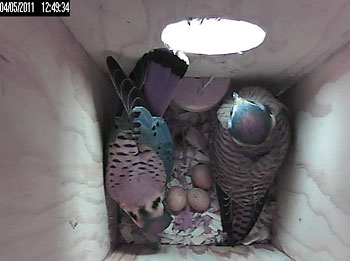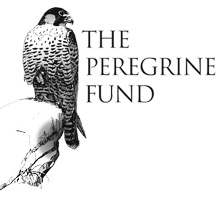American Kestrel Genoscape
The Full Cycle Phenology Project
The Full Cycle Phenology Project brings together a group of diverse and uniquely qualified collaborators from Boise State University, the American Kestrel Partnership, HawkWatch International, St. Mary’s University, Environmental Laboratory of the U.S. Army Engineer Research and Development Center, and the University of California, Los Angeles. This project will combine cutting edge genetic techniques and a large-scale collaboration of professional and citizen scientists across the western hemisphere to find out more about migratory connectivity, population change, and the impacts of climate change on the American Kestrel and other migratory birds.
We are currently collecting feather samples across the breeding range of the American kestrel for genetic analysis (see Full Cycle Phenology website to get involved).
As part of the Full Cycle Phenology Project, the American Kestrel Partnership (AKP) is collaborating with Boise State University, UCLA, and Hawkwatch International to create the American Kestrel Genoscape Project. This page provides more details on the project, including preliminary results, and highlights the role of our partners in this project. Please read on to learn how to collect and submit samples this 2017 breeding season.
What is a 'Genoscape'?
You likely know that all individuals have slight variations in their genetic code. This also goes for populations within a species. Without getting too technical, populations are groups of individuals that interbreed or have the potential to interbreed. Therefore, individuals within a population have more similar genetic codes to each other than to individuals from other populations. By looking at the genetic codes across lots of individuals across space (be it a landscape, state, region, or even continent) we can determine where different populations exist. The map of these genetically distinct populations across geographical space, we call a genoscape (see example below).
Upon understanding a species' genoscape, we can then screen individuals to figure out which population they are from. This is the basis of UCLA's Bird Genoscape Project, which is looking at genetic samples of several migratory bird species to understand where populations breed, migrate, and over-winter for each species. In the map below you see the genoscape and migration map for populations of the Wilson's Warbler from a study led by Kristen Ruegg at UCLA; this was the first map produced using this method and revolutionized how we will understand the migration patterns of avian species. We are using this technique for the American Kestrel Genoscape Project.

Understanding this figure:
Thanks to AKP partners like you, we are well on our way to creating a map of American Kestrel breeding populations. Created from analysis of blood samples sent to us during the past two years, this map shows genetically distinct groups of American Kestrels that represent potentially unique breeding populations. Each color on the map represents a genetically distinct group and the size of the circle represents how many samples we have from that general location. For example, you can see that the Texas circle is a different color (yellow) than all others, indicating that kestrels in Texas are genetically differentiated from those of other locations. The boxed figure shows the genetic similarities between all of the 191 blood samples; the color of the dot represents where the sample was collected and corresponds to the colors on the map. The further the dots are from each other in the box, the less the the samples have in common genetically. Again, you see that the Texas samples (yellow) are grouped pretty far away from other samples, for example. We could say the same for the Alaska samples, in purple. This is just the tip of the iceberg though and there is a lot more for us to learn. Therefore, we need many more samples to determine if kestrels in these areas represent true genetically distinct breeding populations!
How will this help us uncover causes of decline for the American Kestrel?
The American Kestrel Genoscape will allow us to “track” birds across all seasons. We can collect a feather from a migrating or wintering kestrel and figure out where that bird was born. By following kestrels across their full annual cycle, we can start to look for possible threats to kestrels in those locations since they spend so much of their life away from the breeding grounds. For example, we know that the most severe kestrel declines have taken place in the northeast US: according to the Breeding Bird Survey, American Kestrel breeding populations in the northeast US have declined by 88% since the 1960s! Are these birds facing major threats during migration or while over-wintering? The Genoscape project will get us much closer to answering this important question!
American Kestrel Genoscape Project: Preliminary findings
We have started building a genoscape map for breeding American Kestrels using blood collected from birds on their breeding grounds thanks to AKP partners like you! In the map below, you can see our preliminary findings.
Where we need samples
To move forward we need to get more samples from across the breeding range to fill in many gaps, particularly in central North America. Check out the map to see where we really NEED samples! This is where YOU come in as an owner of a high priority nest box.
 Understanding this figure:
Understanding this figure:
This map shows AKP partner nest box locations. High priority nest boxes (where we do not have samples) are shown in red, medium priority nest boxes (where we have a few samples) are shown in yellow, and low priority nest boxes (where we have a high number of samples) are shown in green. We welcome samples from all locations, but if you monitor one of these red nest boxes, WE NEED YOUR HELP!
I want to collect and send samples, what should I do?
We are seeking feather samples plucked from the breast of one American Kestrel nestling per nest during the 2017 breeding season. We do not want more than one nestling per nest to be sampled because we need unrelated individuals. Each sample should contain 2 feathers plucked from an individual (the 2nd feather is insurance against the 1st feather not providing sufficient DNA). The skin cells attached to the feather tip provide sufficient DNA for our method; therefore, feathers do not have to be blood feathers.
We will be happy to accept as few as one sample and up to about 25 samples from any given monitoring area. Feathers can be plucked with with your bare hand (don't need gloves) and stored in a coin envelope that we will send you. Samples should be kept at room temperature or in the refrigerator and shipped together to us at the end of the season. We will send you a pre-paid fed-ex label for free shipping.We need you to collect certain information, including nestling age and sampling date, and include this information on the sample envelope AND in a spreadsheet. You will need proper state and federal permits to collect feather samples.
We'll send you protocol details when you sign up. Please visit the Full Annual Cycle website to learn more about the American Kestrel Genoscape and to sign up if you want to contribute feathers for this project. (Signing up to contribute doesn't bind you to anything, but it helps us organize info from our contributors and potential contributors).
Thanks for your partnership in kestrel conservation,
American Kestrel Genoscape Team

 Understanding this figure:
Understanding this figure:





